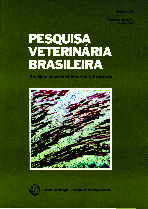 |
|
|
|
Year 2001 - Volume 21, Number 3
|

|
Spontaneous poisoning in sheep by Senecio brasiliensis (Asteraceae) in southern Brazil, 21(3):123-138
|
ABSTRACT.- Ilha M.R.S., Loretti A.P., Barros S.S., Barros C.S.L. 2001. [Spontaneous poisoning in sheep by Senecio brasiliensis (Asteraceae) in southern Brazil] Intoxicação espontânea por Senecio brasiliensis (Asteraceae) em ovinos no Rio Grande do Sul. Pesquisa Veterinária Brasileira 21(3):123-138. Depto Patologia, Universidade Federal de Santa Maria, 97105-900 Santa Maria, RS, Brazil. E-mail: ilha76@mailcity.com
An outbreak of spontaneous Senecio brasiliensis poisoning in grazing sheep in the county of Mata, Rio Grande do Sul, southern Brazil, is described. The disease occurred on one farm in middlejanuary 1997. Fifty-one (54.25%) out of 94 sheep were affected, and 50 animals (53.2%) died. This flock of sheep had been grazing for approximately 7 months (from June 1996 to January 1997) in paddocks heavily infested with S. brasiliensis. Clinical signs included photodermatitis, progressive emaciation, apathy, weakness, neurological signs such as drownsiness, aimless walking and unsteady gait, jaundice and hemoglobinuria. There was amelioration of the skin lesions in those sheep that developed hepatogenous photosensitization. Main necropsy findings in 9 sheep included small, firm, tan or greenish liver with few to numerous small, yellowish, well-circumscribed nodules measuring up to 3 mm in diameter and randomly scattered throughout the hepatic parenchyma. There was also marked distension of the gallbladder which contained large amounts of inspissated, dark green bile and straw-colored cavitary effusions (hydropericardium and ascitis). Five sheep developed lethal acute hemolytic crisis, secondary to massive release into the blood stream of copper accumulated in the liver (hepatogenous chronic copper poisoning). Apart from the aforementioned liver lesions, other gross findings in those animals included severe and diffuse jaundice, dark brown urine (hemoglobinuria) and swollen, friable, finely stippled or diffusely dark kidneys. The main histopathological findings included hepatomegalocytosis, biliary ductal proliferation (bile duct hyperplasia) and moderate periportal fibrosis. The portal triads were infiltrated with variable numbers of mononuclear cells. There was heavy accumulation of brownish pigment in macrophages identified as ceroid or copper with PAS and rhodanine stainings, respectively. Those ceroid and copper-laden macrophages were scattered on the remnant hepatic parenchyma or formed small aggregates in the portal triads. Main histopathological findings in the kidneys of 5 sheep, that developed fatal hepatogenous chronic copper poisoning, included tubular nephrosis, accumulation of hemoglobin and hemosiderin in epithelial tubular cells and hemoglobin casts (hemoglobinuric nephrosis). Morphological evidence of hepatic encephalopathy included spongy degeneration (status spongiosus) of the cerebral white matter. Ultrastructural changes in the tiver of affected sheep included degenerative hepatocellular changes of varying severity. There was accumulation of numerous lipid droplets in the cytoplasm of the hepatocytes and lysosomes containing substances of high electron-density that corresponded to ceroid-lipofuscin in most of the cases. In addition, there was mild swelling of the rough endoplasmic reticulum and moderate hyperplasia of the smooth endoplasmic reticulum in some areas of the cytoplasm of the hepatocytes. Proximal convoluted tubular epithelial cells showed intracellular edema anda variety of mitochondrial degenerative changes. These included disarrangement and breakup of cristae, finely granular matrix, accumulation of lipid globules and rupture of the membranes in a few cases. Many epithelial tubular cells displayed substances of high electron-densitywithin lysosomes. Chemical analysis of copper in tiver and kidney samples of affected sheep revealed high concentrations varying from 369 ppm to 1248 ppm in the tiver and ranging from 152 ppm to 687 ppm in the kidneys (dry matter). The diagnosis of Senecio brasiliensis poisoning was based on epidemiological data, clinical signs, necropsy findings, histological lesions and laboratory data. |
| |
|
|
| |
|
 |